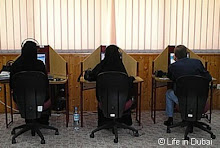Feel free to ignore this bit, I first need to rant about the dreadful new Gulf News web site. Again.
I can't believe how bad it is, it's now without doubt one of the worst newspaper sites on the web. I simply don't understand how anybody involved can think it's better than the one it replaced.
I'll get to the real post in a minute, which was triggered by a story in the India news section of today's Gulf News.
That section extends over four full pages, about a dozen stories.
What does the website give us in the India news section? Three of today's stories, then it travels back in time to old stories from earlier issues.
So much for the modern, up-to-the-minute, instant internet.
I tried searching for the story I want but: "
Sorry your search did not find any results"
A dozen of today's stories are considered worth publishing in the paper but for the website only three are deemed worthy, and old stories dominate.
Anyone else as frustrated with it as I am? How about a petition to encourage them to scrap it and go back to the sensible, useable design?
And so to the real post.
There's an interesting example of how spin is put on stories, how facts are presented very differently, an example of why getting our news from one source is dangerous. A demonstration that we need to get information from a number of sources and use our brains to work out what's really happening.
The stories relate to a survey of over 6000 students from eight countries, including 1,100 from India, conducted by IDP Education.
Gulf News uses a wire story from PTI, the Press Trust of India, headed:
"Australia could see 50% fall in Indian students"
The spin on the PTI report is transparent if you give it any thought at all, or if you balance it against other reports.
It begins
"In the backdrop of a spate of racial attacks in Australia, Down Under could witness a 50 per cent drop in Indian students in the next session."Immediately you get the way they're going with this.
It goes on to claim the CEO of IDP Education:
"...felt the fall in numbers might be entirely due to safety issues, global slowdown could also play a part in it."That's followed immediately by what he actually said:
"We have the GFC (global financial crisis), which has obviously impacted upon families in India and that’s evident by the fact that the applications for other countries are way down, particularly the US."What he said and what they
say he said are two totally different things.
The GN PTI report itself ends with another quote from the CEO, basically contradicting its own spin on the story. It says:
"The somewhat surprising result and indeed promising result is that they believe Australia to be the safest destination of all the English speaking destinations - and by quite a margin."In Oz the story says:
"Australia tops poll for student safety.
Despite media coverage here and overseas of violent attacks on Indian students, nearly 40 per cent of respondents ticked Australia as the safest place when asked to choose from a list comprising Australia, the US, Britain, New Zealand and Canada. The US ranked last for safety, with 4.3 per cent.
IDP Education chief executive Anthony Pollock said the findings in relation to Indian students reflected the 'private opinion of students which may be a little better disposed towards Australia than the public opinion in the press'.
He said IDP was expecting a 50 per cent drop in Indian student enrolments next year because of negative media coverage in India of attacks on Indian students, the global economic squeeze and a government crackdown on bad practices in the international education industry." Same story about the same research but two very different impressions given.
Thanks to the failings of the new Gulf News website I can't give you a link because the story isn't there. I can give you a link to a different site which has part of the PTI story though, so I'll do that.
You can find a story based on the PTI report
here.The alternative interpretation is
here.
















